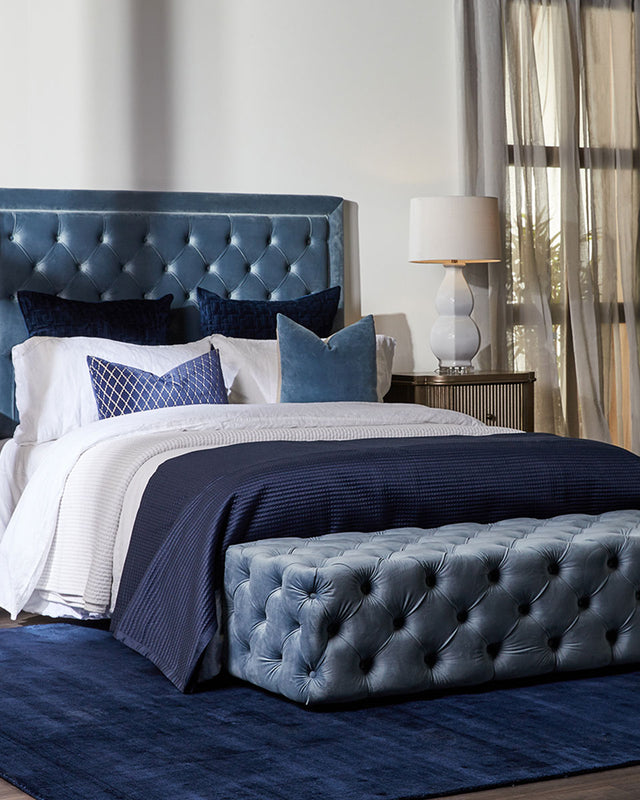Product Care
Marble is a natural stone material that is organically porous, soft, and more sensitive to chemicals than other stones such as granite. The marble stone will show wear sooner than other stone surfaces, but it can be restored with correct care and polishing by a stone care professional or restoration specialist.
Since marble is a porous stone, any substances that are left on marble surfaces can stain. We highly recommend cleaning any spills or food crumbs immediately with a lightly dampened cloth as this will minimise the imperfections to the item. Avoid leaving cold cups or drink bottles as water condensation will also stain the marble. We highly recommend the use of coasters and placemats to further protect the integrity of the stone.
Examples of substances that may stain, etch, or mark the marble are:
- Sauces
- Oils
- Acidic
- Salad dressings
- Fruit juices
- Soft drinks
- Wine and other alcohols
If any of these substances spill on your marble surface, we recommend cleaning immediately with a damp cloth and wipe dry. Blot spills as wiping the area will spread the spill.
Avoid the use of cleaning solutions below as some may stain, corrode or tarnish marble surfaces:
- General-purpose cleaners
- Bathroom cleaners
- Grout cleaners
- Descaling solutions
- Vinegar
- Bleach
- Ammonia
- Abrasive scrubs
- Acid based cleaners
- Soft cleansers
All timber surfaces will mellow and mature in colour over time. These aged and rustic features should be appreciated as part of the look and are not manufacturing defects. If you would like to see the item before dispatch to ensure you are happy with the colouring and table characteristics, please ask our sales team. Dissatisfaction with this natural finish look will be considered a change of mind and not a fault.
Please note that assembly should be completed by capable person/s with assembly experience.Eleganté Homewares will accept no liability for furniture damage or injury should the furniture be assembled incorrectly.
General Care Instructions:
- Check table fixings periodically as it can loosen over time; re-tighten when necessary and avoid over-tightening
- Every 8-12 months, apply a clear protective varnish (purchased from your local hardware store) to the furniture to protect the surface and maintain quality. Spot test before applying as some timbers can stain darker
- Place the table indoors and away from direct heat sources, such as sunlight, heating, and windows. The nature of reclaimed timber is not suitable for outdoor use
- Placemats and coasters are recommended to further protect the integrity of the timber
- Immediately blot any spills or sticky residue that come into contact with the timber. Use a slightly damp cloth, wiping in the direction of the wood grain followed by a dry towel to remove remaining moisture
- Frequently dust with a dry towel or duster to remove abrasive build ups of dust
- Avoid direct contact with liquids or food scraps.
- Drag the table or legs when moving. Ask for assistance and lift the table with a minimum of two people
- Use detergents or cleaning chemicals to the surface as it will damage the timber.
General Care Instructions:
- Clean and polish regularly. Depending on usage it is recommended to polish your solid timber items every 6 - 8 months
- Use coasters and placemats to prevent water rings and scratches
- Wood swells in high humidity and shrinks in low. These changes can warp the wood and in some circumstances cause the item to break. It is recommended to invest in a humidifier/dehumidifier if you live in an area that experiences extreme weather fluctuations
- Dust the furniture every few days or so to ensure it continues to look shiny and prevents the dust from settling into the wood
- Immediately blot any spills or sticky residue that come into contact with the timber. Use a slightly damp cloth, wiping in the direction of the wood grain followed by a dry towel to remove remaining moisture
- Place the table indoors and away from direct heat sources, such as sunlight, heating, and windows. Direct heat sources can cause the timber to warp and, in extreme cases, break due to the temperature.
- Use solvents or chemicals on the items. Select your cleaning products carefully and avoid cleaners that contain bleach, alcohol, ammonia based or contain silicone or any other chemicals that can stain or strip wood. Ideally look for natural alternatives
- Place in an outdoor space. These tables are not suitable for an outdoor space.
- Use coloured plastic on the timber. Coloured plastic can sometimes seep it’s colour into the wood and affect the timbers shape because of the heat and humidity.
General Care Instructions:
- Depending on usage, a weekly vacuum with low suction and a soft brush accessory will remove dust and damaging dirt particles will help extend the life of your fabric and furniture
- Dab spills immediately with a soft, clean, white cloth or absorbent paper towel. If possible, do not let spills dry and clean them as soon as possible
- Pilling can occur on occasion and is not considered a fault. Fabric pills can be removed by a power operated pilling tool available at most general home supply stores
- Professionally clean the fabric bi-annually or yearly
- Rotate reversible seat cushions regularly to develop even cushioning on a sofa.
- Place the items near direct heat sources, such as sunlight, heating, and windows
- Keep sharp or abrasive items such as shoes on or near your fabrics. Abrasive items can pull fibres which can develop into holes or tears
- Use the item in wet clothing as it can leave a watermark on the fabric and can contribute to beaching, mould growth, and transfer dye
- Use chemicals, alcohol or detergents to clean the fabrics as this may cause greater damage and discolouration.
General Care Instructions:
- Depending on usage, a weekly vacuum with low suction and a soft brush accessory will remove dust and damaging dirt particles will help extend the life of your fabric and furniture
- Dab spills immediately with a soft, clean, white cloth or absorbent paper towel. If possible, do not let spills dry and clean them as soon as possible
- Pilling can occur on occasion and is not considered a fault. Use a soft dry brush in the direction of the pile to restore the natural fabric direction and loft
- Professionally clean the fabric bi-annually or yearly
- Rotate reversible seat cushions regularly to develop even cushioning on a sofa.
- Place the items near direct heat sources, such as sunlight, heating, and windows.
- Keep sharp or abrasive items such as shoes on or near your fabrics. Abrasive items can pull fibres which can develop into holes or tears
- Use the item in wet clothing as it can leave a watermark on the fabric and can contribute to beaching, mould growth, and transfer dye
- Use chemicals, alcohol or detergents to clean the fabrics as this may cause greater damage and discolouration.
General Care Instructions:
- Dust regularly with a slightly damp, soft, lint-free cloth
- Wipe dry with a dry, soft cloth in the direction of the natural wood grain
- Clean spills immediately with a damp cloth
- Apply a good furniture polish with a soft cloth twice a year
- Use coasters at all times to prevent surface damage
- Avoid placing the item in direct sunlight to prolong product longevity.
- Use aerosol-powered cleaners or polishes
- Use polishes containing waxes or abrasives, or polishes that are oil based or alcohol based
- Place a pot plant on the veneer surface unless it’s in a water tight container or drip tray
- Place hot, wet, or moist items directly onto the table
- Place the product in an extremely high or low humidity area.
Real Leather General Care Instructions:
- Dust weekly or use a soft vacuum attachment to avoid the leather being scratched by loose particles
- Depending on how often you use your leather furniture, apply a leather cleaner and condition once every 6-8 weeks
- Immediately blot any spills that come into contact with the leather. Use a clean and white paper towel, gently blotting the affected area. Do not wipe as it may cause the spill to spread and damage other areas
- Avoid vigorous rubbing when cleaning the leather.
- Over clean the furniture, which can damage the protective layer and cause the leather to deteriorate prematurely
- Soak the leather in any liquids
- Use detergents, alcohol, chemicals, soaps, shoe polish, wax, window cleaner, silicone, saddle soap or any cleaning product not designed for leather as these may cause damage and discolouration
- Sit on the furniture with wet swimming clothes or towels, which can leave a watermark on the leather – contributing to bleaching, mould growth and dye transfer.
General Care Instructions:
- PU leather should be dusted with a dry or slightly damp lint free cloth
- We recommend using a faux leather cleaning and maintenance kit on the item and use as directed on the packaging.
- Cleaning can also be done with warm water and some not abrasive.
- Do not place in direct sunlight. Faux leathers can dry out the material and cause damage to the frames
- Clothes that are indigo dyed (like jeans) or strong colours can transfer onto light colours. Be sure to give this a wipe as soon as you notice it, as it’s the kind of stain that will penetrate if left. A quick wipe down with a baby wipe after use should resolve this if attended to quickly however results may vary and this is not seen as a fault of the material
- Do not use abrasive cleaning agents on the material. Harsh chemicals like bleach and detergents.
General Care Instructions:
- Dust glass regularly with a soft and dry cloth
- Clean with glass cleaner, following the bottle instructions
- Use place mats and coasters to protect the glass and prolong its longevity
- For frosted glass, place the frosted side down to avoid damaging the surface.
- Subject the glass to thermal or mechanical stress as it can weaken, break or shatter
- Use the glass surface as a chopping area, and avoid contact with sharp or hard objects
- Allow greasy or dirty items come into contact with the frosted side of frosted glass
- Carelessly handle the glass product
- Drop objects onto the glass surface.
Preservative Maintenance:
- Store your outdoor furniture in a dry and shaded area when not in use or during periods of inclement weather
- Canvas, painted metal or timber furniture should be stored undercover after use
- Timber furniture will naturally expand and contract due to changes in humidity and temperature. This can cause timber to split and/ or fade in colour when left exposed to outdoor elements, which is a natural occurrence and should not be considered as a fault.
- Furniture made from polyester, synthetic wicker and aluminium can be washed down with warm soapy water and left to dry naturally
- Clean and treat timber furniture regularly to maintain its integrity
- Clean the entire surface of upholstered pieces, from seam to seam, to avoid water rings and stains.
- Leave furniture uncovered in direct sunlight for extended periods of time as it may cause warping or splitting under the heat
- Leave furniture outside during periods of inclement weather (e.g. storms or extremely hot weather)
- Scrub, use hard bristle brushes or other abrasive cleaning methods when cleaning upholstered pieces
- Fold furniture when wet as it will get mouldy or rusty



